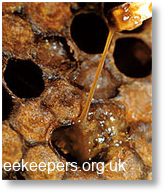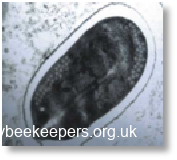Just like any other member of the animal kingdom, honey bees have their fair share of ailments. There are too many possible diseases and ailments that can affect honey bees to list here, so this section gives a brief introduction to the main bee diseases.
Dealing with bee disease has become a much more significant issue to beekeepers in the last 10 years. Bees have evolved over many millions of years and over that time have adapted to their local environments and all the “bugs” that exits there. Weak, susceptible colonies died out whilst strong, disease-tolerant bees survived, thus further strengthening the local gene pool. For the majority of the time mankind has been keeping bees in managed colonies, bee disease – although always a potential problem – was rarely catastrophic. However, in relatively recent times (the last 60 years or so) bees have been moved large distances within and between countries – in some cases on an industrial scale. Different species and strains of bee have been increasingly exported far and wide.
Some may argue that this artificial migration of bees creates genetic diversity in local populations allowing bees to develop resistance to certain diseases more readily. The alternative view is that artificial bee migration causes disease agents to spread to areas where bees have no adaptations to deal with such diseases. Whatever the reasons, bee disease is something all beekeepers should consider in their day-to-day management of their colonies.
Rather than go into any depth about the various diseases affecting bees, the list below gives links to official information about the main diseases beekeepers should look out for and manage accordingly. The pictures give links to the official advisory leaflets or web pages of the National Bee Unit of the Food and Environment Research Agency (BeeBase).

Caused by the varroa mite (Varroa destructor). The mite was previously found on the Asian honey bee (Apis cerana) but made the jump to the European honey bee (Apis mellifera) in the early 1960s following the introduction of European bees to the Philippines in an attempt to improve the honey gathering abilities of the Asian bee. The mite finally made its way to the UK in 1992.

Foul Brood disease – as suggested by the name – affects the brood of bees. This disease is probably the most dreaded of all bee diseases as it is either difficult to treat or untreatable depending on the type.
All foul brood diseases are notifiable under the law. Any suspected case must be reported to the National Bee Unit or a Bee Inspector.
European Foul Brood (EFB) – Caused by the bacterium Melissococcus plutonius. The symptoms are a foul smell, discoloured and contorted larvae that eventually dry to form brown scales in the cell. EFB may be treatable with antibiotics or by the “shook swarm technique” where the adult bees are separated from the brood by shaking them into a hive of new foundation.
American Foul Brood (AFB) – Caused by the bacterium Paenibacillus larvae. Symptoms include sunken, wet looking cell cappings, larval remains that become stringy and dry out to form a hard black scale. AFB is considered untreatable and all affected colonies must be dealt with in situ. This typically entails all the frames being burned in a pit and the main hive parts being thoroughly scorched with a blow torch.

Two species of microsporidia (spore forming, fungi-like, single cells parasites) can affect honey bees. Nosema apis is thought to be behind most cases of nosema infection (nosemosis) in European bees however, Nosema ceranae (normally affecting the Asian honey bee) has also been found to in A mellifera.
The parasite lives in the gut of bees and tends to cause dysentery (noted by brown spotting at the entrance). As other bees clear up the mess in the cells they pick up spores and continue the infection of the colony. N. apis may lead to a reduction in the activity of affected bees, but providing the bees are able to fly and not confined by bad weather, they will clear their guts, eradicating the infection.
Nosema ceranae is thought to be more problematic and some believe that it is responsible for depleting the colony due to bees running out of energy whilst away from the hive and dying in the cold of the night.
Nosemosis can, in either case, reduce productivity and weaken the colony allowing other pathogens to take hold.

Alternatively known as the tracheal mite (Acarapis woodi), acarine is caused by a microscopic mite that infest the air tubes (trachea) of the bee and sucks the bee’s haemolymph. The bees often tolerate the mite with no obvious effects. However, it is thought that acarine can reduce the life span of bees causing over wintering colonies to dwindle.
It is likely that acarine has its greatest affects when the bees are already weakened by other diseases such as viruses or varoosis.

Most colonies will have chalkbrood from time to time. Caused by a fungus, chalkbrood affects developing brood within the cells causing the larva to dry out and look like a piece of chalk.
Colonies may be more susceptible if affected by other stresses (e.g. disease, bad weather, poor food availability, etc). However, chalkbrood is rarely a problem.
There are many other bee diseases that routinely affect bees (and some which may arrive on UK shores in the future). If you suspect something is wrong with your bees either contact the National Bee Unit or your bee inspector for advice.
